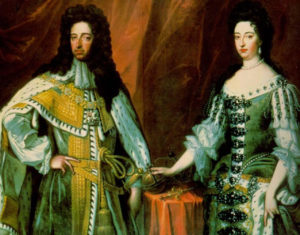
Writing in Old Furniture in 1929, G. B. Hughes noted the absence of firebacks bearing the arms of King William III and Queen Mary II, a statement which my cataloguing of over 800 backs has failed to disprove. Together, and from 1694 William alone, they reigned for 14 years and the strong Dutch influence that William’s tenure of the throne stimulated saw the importation of a distinctive style of firebacks that had been popular in the Netherlands since that country gained its independence from Spain in 1648. Furthermore, English pastiches of the Dutch style were also being produced in some quantity, and continued to do so throughout the first quarter of the eighteenth century.
So this continental fireback with William and Mary’s arms is of great interest. It is a handsome casting, albeit a copy, but close examination reveals that, as might be expected, the arms displayed should be interpreted from a Dutch perspective, not an English one. The arms displayed are, in fact, those of William as Prince of Orange rather than as King of England, Scotland and Ireland, though they date from when he was king.

When was the fireback made? As a princess, Mary’s arms will have been a variation of those of her father, James, Duke of York, the difference being a label across the top. When her father was crowned king in 1685, he had no sons so Mary became heir presumptive, and her coat of arms reflected this change in status with a simple label of three points. However, the arms on the fireback show William’s arms as Prince of Orange impaling (i.e. next to) Mary’s arms without the label, suggesting that it dates to the period between 1689, when Mary had become queen, and her death in 1694.

As king and queen of England the combined arms of William and Mary were different. King William’s arms were the same as Mary’s save for the addition of an escutcheon of Nassau, the Dutch royal house, and as before they were impaled with Mary’s arms. The Scottish version of the arms was almost the same, though the red lion rampant was given precedence. It is a fireback with this combination of arms that seems never to have been made. Perhaps the intricacy of the carving made pattern makers baulk at the prospect of rendering the shield effectively, though their continental counterpart seems to have done a pretty good job.
*W. C. Sellar and R. J. Yeatman, 1066 and all that (London, Methuen, 1930), ch. 38.
